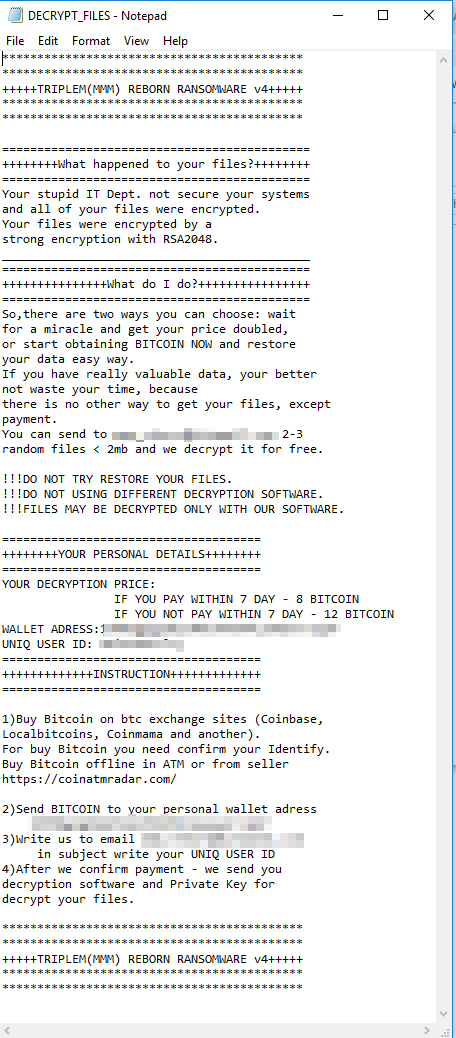Ransom.Win32.TRIPLEM.THCBGAI
Trojan:Win32/Occamy.B(Microsoft); Trojan.PWS.Banker1.30223(DrWeb)
Windows


Threat Type: Ransomware
Destructiveness: No
Encrypted: No
In the wild: Yes
OVERVIEW
This Ransomware arrives on a system as a file dropped by other malware or as a file downloaded unknowingly by users when visiting malicious sites.
It deletes itself after execution.
It encrypts files with specific file extensions. It drops files as ransom note.
TECHNICAL DETAILS
Arrival Details
This Ransomware arrives on a system as a file dropped by other malware or as a file downloaded unknowingly by users when visiting malicious sites.
Installation
This Ransomware drops the following files:
- {Malware Directory}\{8 Random Characters}.{3 Random Characters}.exe
- {Malware Directory}\ecorp.bat
It adds the following processes:
- cmd.exe /C vssadmin.exe delete shadows /all /Quiet -> deletes all shadow copies
- cmd.exe /C WMIC.exe shadowcopy delete -> deletes all shadow copies
- cmd.exe /C Bcdedit.exe /set {default} recoveryenabled no -> Disables Windows Recovery on Startup
- cmd.exe /C Bcedit.exe /set {default} bootstatuspolicy ignoreallfailures -> disable system's trigger to call the Error Recovery screen on startup
- cmd.exe /c "{Malware Directory}\ecorp.bat" -> Delete malware
- cmd.exe /c wevtutil.exe cl Security
- cmd.exe /c wevtutil.exe cl System
- cmd.exe /c wevtutil.exe cl Application
Other Details
This Ransomware deletes itself after execution.
Ransomware Routine
This Ransomware encrypts files with the following extensions:
- .accdb
- .adi
- .adt
- .ADX
- .adx
- .ai
- .altr
- .arw
- .asmx
- .asp
- .aspx
- .bak
- .bat
- .bkf
- .cdr
- .cdr
- .css
- .csv
- .ctf
- .data
- .DBF
- .dis
- .doc
- .docx
- .dst
- .dwf
- .dwg
- .ecw
- .eps
- .eps
- .err
- .fbk
- .FBK
- .fp7
- .FP7
- .frm
- .html
- .jpeg
- .JPG
- .jpg
- .js
- .LDF
- .ldf
- .ltf
- .mdb
- .MDF
- .mdf
- .mkd
- .msg
- .myd
- .myi
- .ndf
- .odt
- .php
- .pix
- .pmd
- .png
- .ppt
- .pptx
- .prn
- .psd
- .pxf
- .QBB
- .qbb
- .qbo
- .qbw
- .QBW
- .qbw
- .rpt
- .sldprt
- .sln
- .sql
- .sqlite
- .sVn
- .svn
- .tif
- .tlf
- .TLG
- .tlg
- .trn
- .txt
- .xls
- .xlsx
- .xml
- .zip
- .ziz
It avoids encrypting files with the following strings in their file path:
- ProgramData
- Program Files
- Pictures
- Music
- Package Cache
- VMware
- \Microsoft\
- Appdata
- Activators
- Program Files (x86)
- Windows
- Program Data
- All Users
- Users\Default
It drops the following file(s) as ransom note:
- {Encrypted Directory}\DECRYPT_FILES.txt
It leaves text files that serve as ransom notes containing the following text:
SOLUTION
Step 1
Before doing any scans, Windows 7, Windows 8, Windows 8.1, and Windows 10 users must disable System Restore to allow full scanning of their computers.
Step 2
Note that not all files, folders, and registry keys and entries are installed on your computer during this malware's/spyware's/grayware's execution. This may be due to incomplete installation or other operating system conditions. If you do not find the same files/folders/registry information, please proceed to the next step.
Step 3
Restart in Safe Mode
Step 4
Search and delete this file
- {Encrypted Directory}\DECRYPT_FILES.txt
- {Malware Directory}\{8 Random Characters}.{3 Random Characters}.exe
- {Malware Directory}\ecorp.bat
Step 5
Restart in normal mode and scan your computer with your Trend Micro product for files detected as Ransom.Win32.TRIPLEM.THCBGAI. If the detected files have already been cleaned, deleted, or quarantined by your Trend Micro product, no further step is required. You may opt to simply delete the quarantined files. Please check this Knowledge Base page for more information.
Step 6
Restore encrypted files from backup.
Did this description help? Tell us how we did.


